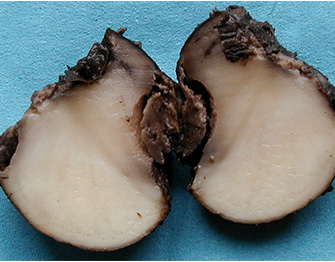Please click here to access the main AHDB website and other sectors.
- Home
- Knowledge library
- Managing blackleg disease and soft rot in potatoes
Managing blackleg disease and soft rot in potatoes
Blackleg is one of the key diseases across all sectors of the potato industry in Great Britain. It is caused by several related bacteria that can also cause soft rotting in tubers.
Why blackleg-causing bacteria are an issue
The presence of blackleg results in the downgrading or rejection of seed crops. The bacteria involved also cause losses in ware crops, especially under wet conditions, and can result in the breakdown of tubers in store, or after they have been washed and packed. Susceptibility to blackleg has been the downfall of several otherwise attractive varieties.
Bacteria causing blackleg and soft rot
Over the last ten years, advances in the techniques used to discriminate different bacteria have resulted in new species being defined and some of the previous names, such as Erwinia carotovora and Erwinia chrysanthemi, are no longer used. Pectobacterium and Dickeya species are the main blackleg and soft rot-causing bacteria in potatoes.
Across Europe, there are currently several species of concern (D. dianthicola, D. solani, P. atrosepticum, P. brasiliense, P. carotovorum and P. parmentieri (formerly P. wasabiae). New species continue to be discovered but their economic importance and distribution have not been extensively studied.
The economically important species differ in their optimal temperature for growth and there is variation in the distribution of the species.
- P. atrosepticum can cause blackleg at lower soil temperatures (less than 15oC) than other Pectobacterium or Dickeya species. It is the main cause of blackleg in GB
- Other species, including P. brasiliense, P. parmentieri, D. dianthicola and D. solani have also been found to cause blackleg in some parts of GB, but only to a limited extent

Symptoms in the crop

Bacteria causing blackleg and soft rot
Over the last ten years, advances in the techniques used to discriminate different bacteria have resulted in new species being defined and some of the previous names, such as Erwinia carotovora and Erwinia chrysanthemi, are no longer used. Pectobacterium and Dickeya species are the main blackleg and soft rot-causing bacteria in potatoes.
Across Europe, there are currently several species of concern (D. dianthicola, D. solani, P. atrosepticum, P. brasiliense, P. carotovorum and P. parmentieri (formerly P. wasabiae). New species continue to be discovered but their economic importance and distribution have not been extensively studied.
The economically important species differ in their optimal temperature for growth and there is variation in the distribution of the species.
- P. atrosepticum can cause blackleg at lower soil temperatures (less than 15oC) than other Pectobacterium or Dickeya species. It is the main cause of blackleg in GB
- Other species, including P. brasiliense, P. parmentieri, D. dianthicola and D. solani have also been found to cause blackleg in some parts of GB, but only to a limited extent
Sources of bacterial infection
- Sources of initial infection of high-grade seed in the first field generation include wind- or rain-dispersed aerosols from neighbouring infected potato crops or outgrade piles, contaminated machinery, surface water, soil, groundwater and possibly by free-living nematodes and insects
- Contaminated seed tubers are important sources of inoculum in later field generations
- Blackleg bacteria can infect growing plants systemically from the mother plant via the stolon or via wounds
- Infection through wounds above soil level can lead to aerial blackleg, especially during wet weather or overhead irrigation
- Under disease conducive conditions, bacterial loading on the surface of tubers or within lenticels generally increases in seed tuber stocks after each field generation
Symptoms
Disease initiates when the bacteria multiply to a critical threshold population under conducive environmental conditions such as condensation during storage and when temperatures are greater than 4°C.
Visit the potatoes diseases page for more information on symptoms
Management
- There are no tuber treatments or products that can be applied in the field to control blackleg
- Seed testing for bacterial loading can give an assessment of risk but bacterial levels, and subsequent symptoms, can increase rapidly under favourable conditions, or decrease in unfavourable conditions
- All varieties of potato are susceptible to blackleg and soft rot but some more so than others. Varietal susceptibility is assessed as part of the National List programme and results are reported in the Potato Variety Database
- Excessive irrigation/rainfall can increase tuber contamination and blackleg disease, the latter either from infected tubers or directly from the environment. Improved irrigation management and good field drainage can therefore restrict blackleg development
- Disease incidence and severity increases with duration of tuber wetness. Lift in warm, dry conditions. Dry tubers well before storage. Condensation during storage can initiate bacterial multiplication and soft rot initiation, especially where temperatures are greater than 4oC
- Clean the grader thoroughly before the grading season starts. If possible, disinfect graders between each batch of seed to control cross-contamination
- Strict temperature control and ventilation with dry air is essential to prevent bacterial multiplication during storage and transit
- Rapid haulm destruction is important to reduce bacterial contamination of tubers as the bacteria can multiply on dead plant material prior to full desiccation, especially under wet conditions

